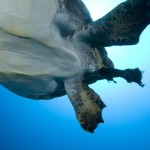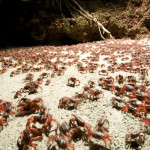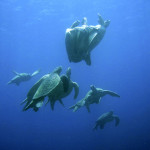A special guest post by Bryan Wallace of Conservation International, featuring original research

In April of last year, I posted a story about how leatherback turtles are deep-sea explorers due to their incredible abilities to cope with the challenging conditions of the deep. The story was related to the hugely successful media conservation campaign, The Great Turtle Race, which allowed people around the world to follow the race of leatherback turtles on their migrations from nesting beaches in Costa Rica to the Galapagos Islands and beyond.
While the Race was a big hit, it only lasted two weeks. This abrupt end to the tracking left many fans (and maybe you, too?) with questions: “But what happened to those turtles? How far did they go? What did they do after reaching the ‘finish line’ at the Galapagos?”
In particular, the leatherback featured in the photo of my previous article has received a lot of attention in the past year (see picture above). That turtle (known as Drexelina in the Great Turtle Race) is 157 cm (>6 ft), long 107 cm (3.5 ft)wide, and probably tips the scales at 350 kg (about 800 lbs)! She was originally seen nesting at Playa Grande, Costa Rica, in 2003/04, and she laid 7 nests in that season. She returned to nest in 2006/07 and laid 12 nests. Big turtle and lots of eggs!
We fitted her for the custom-made backpack carrying a satellite transmitter while she laid her eggs. When a leatherback is nesting, she is in a trance-like state that allows scientists to collect information, samples, and to attach tracking instruments without disturbing the turtle. The first photo, as well as this one, was taken after she had completed her nest, just before she returned to the ocean.

Drexelina hung around Costa Rica for a while after getting her backpack, and had started her migration toward the Galapagos when her transmitter stopped sending us signals after only 72 days of tracking. In that short time, she had traveled almost 1,500 km from the beach (see map below) . This early tag failure was a rare occurrence; almost all other transmitters gave us whereabouts of turtles for many months (about 11 months on average), and one turtle for nearly two years! Turtles traveled more than 8,000 km after leaving Costa Rica. (see all leatherback tracks here.)
What about the rest of the turtles we’ve tracked? They all left Costa Rica after they finished their nesting seasons and headed toward the Galapagos, but that’s all that we know for certain. Of the 11 turtles featured in The Great Turtle Race, and the more than 30 others we’ve tracked over the past 4 years, only 4 turtles are still carrying functioning transmitters (see http://www.topp.org/blog/whats_turtleocity).
Why we lose the signals is very difficult to determine. One likely possibility is that the batteries in the transmitters simply die after about a year to a year and a half, but sometimes sooner. However, because we cannot recollect and recharge those batteries when they die like you can with your iPods and laptops, we lose the signal from that turtle’s transmitter. Another possible explanation is that the harness (the backpack) falls off earlier than it is designed to (18 months). Another possibility is that barnacles and other critters and debris in the ocean encrust the transmitter such that it can no longer send signals to satellites and tell us where the turtle is. Unfortunately, loss of transmitter signal could also mean that a turtle died (of natural causes? after becoming entangled in fishing nets?) and sank beneath the ocean’s surface, taking its transmitter with it.
While what happens after the transmitters stop working is a mystery, the information that we’ve received from the transmitters has shed light on previously poorly understood movement and behavior patterns of leatherbacks near and away from Costa Rica as they traverse the Pacific Ocean. The more we know, the more effective we can make our strategies to ensure that these ocean-going, deep-sea marvels will continue to traverse the Pacific Ocean for many generations.

First photo caption: From left to right, pictured are Bryan Wallace (Conservation International), Rotney Piedra (Director, Las Baulas National Marine Park), Carlos Díaz (Park Ranger), George Shillinger (Stanford University), and Guillermo Briseño (Park Ranger) after attaching a satellite transmitter to an enormous leatherback turtle. After this photo was taken, the turtle returned to the ocean. Photo by Jason Bradley.
Second photo caption: Researchers fit a leatherback turtle with a custom-made backpack carrying a satellite transmitter while she lays her eggs. Sea turtles are in a trance-like state while laying eggs, so this handling does not disturb her. Photo by Jason Bradley.
Third figure caption: The track of the leatherback featured in the photos, which was constructed from the locations relayed by her transmitter to satellites, which then relayed the information to scientists via email. This turtle’s track duration was 72 days and its total length was 1,490 km (930 miles). Figure courtesy of George Shillinger and Mike Castleton.






Gotta get those conversions right!
“157 cm (>6 ft), long 107 cm (3.5 ft)wide, and probably tips the scales at 350 kg (about 800 lbs)!”
157 cm = 5.15 ft.
350kb = 771 lb (ok close enough).
:-)
right you are, lambert!
i guess it’s easier for me to think about turtle size in metric system…
she’s still pretty big, eh?
Wow! Awesome post. I was wondering if you found anything new or interesting in their diving behaviors over the last year of tracking. Any new records (length of time or depth)? Also, I’m very interested in critters living on critters. Do you guys take into account the turtle’s fouling community composition or coverage as variable in your studies?
“Do you guys take into account the turtle’s fouling community composition or coverage as variable in your studies?”
or in setting the odds for the Great Turtle Race?
lol, Stephanie Coburtle had an unfair advantage! I saw Billie stacking barnacles on her shell before the race!
Good questions about fouling communities. A few folks do study barnacle fouling on sea turtles, but not as much on leatherbacks as on other, more coastal species like loggerheads. Eckert and Eckert published a study in the 1980s on leatherback barnacles and showed a shift during the nesting season from oceanic species to more tropical species as the nesting season progressed. I can provide more info if you’d like.
I also had a guy who studies barnacles ask me to collect samples of fouling communities, but nothing ever came of it.
As for new and exciting discoveries, we’re learning about how much ocean currents influence leatherback tracks, because these turtles cross through a highly energetic current field across the equator, but end up in a very low-energy area in the southeastern Pacific.
According to Colbert himself, Billie had unfair advantages that allowed her to win the GTR! Look up the videos of his broadcasts during GTR…hilarious…